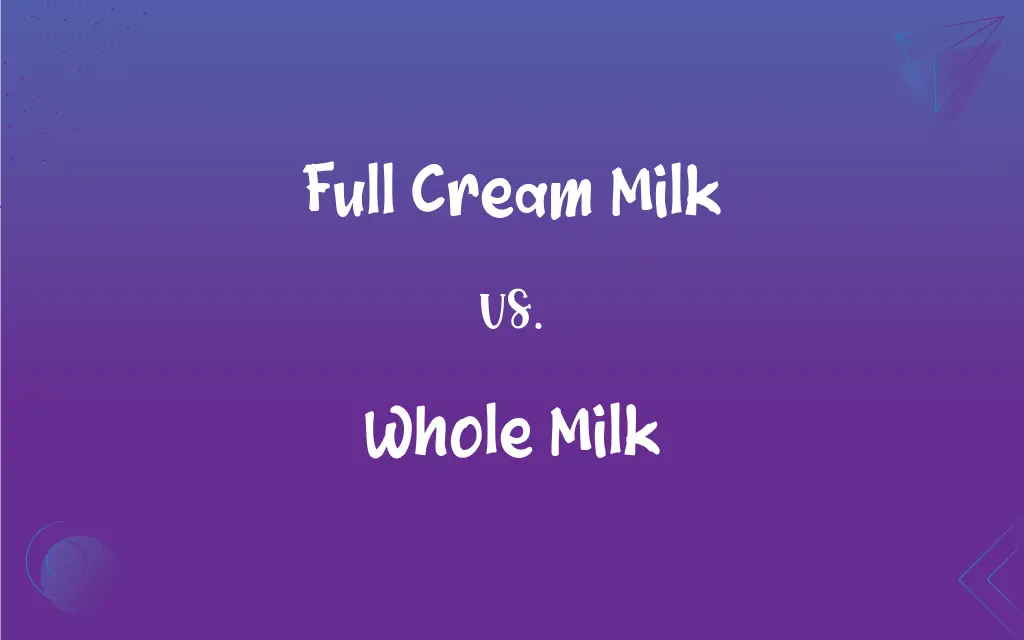Full Cream Milk vs. Whole Milk: What's the Difference?
Edited by Janet White || By Harlon Moss || Published on December 14, 2023
Full Cream Milk refers to rich milk with about 3.5-4% fat, often pasteurized. Whole Milk refers to standard milk with 3.25% fat, commonly used in the US.

Key Differences
Full Cream Milk typically contains a higher fat content, usually around 3.5-4%, making it richer in taste and texture. It is often preferred for its creamy flavor and is used in various culinary applications. Whole Milk, conversely, is standardized to have about 3.25% fat in the United States, offering a balance of taste and nutrition.
In many regions, Full Cream Milk is synonymous with whole milk, but it often denotes a slightly higher fat content. This type of milk is ideal for creating rich dairy products like cream and butter. Whole Milk is a staple in American households, recognized for its nutritional value and versatility in cooking and baking.
Full Cream Milk undergoes pasteurization and homogenization, similar to whole milk, but retains a higher fat percentage. This makes it a popular choice for creamier dairy products. Whole Milk, while also processed for safety, maintains a consistent fat content, making it a preferred choice for daily consumption.
The fat content in Full Cream Milk provides a richer taste, often favored in coffee and desserts. Its creamy texture enhances the flavor of beverages and dishes. Whole Milk, with slightly less fat, is often considered healthier and more suitable for regular drinking, especially in family settings.
Labeling can vary, with Full Cream Milk sometimes referred to as just 'cream milk' in some regions, emphasizing its richness. Whole Milk is typically labeled as such in the US, easily identifiable and widely consumed in various culinary contexts.
ADVERTISEMENT
Comparison Chart
Fat Content
About 3.5-4%
Standardized at 3.25%
Common Usage
Preferred for its creaminess in desserts and coffee
Widely used in cooking, baking, and daily consumption
Nutritional Aspect
Richer in fat, ideal for richer dairy products
Balanced in nutrition, suitable for regular drinking
Labeling
Often labeled as 'full cream' or 'cream milk'
Consistently labeled as 'whole milk' in the US
Texture
Creamier and thicker
Slightly less creamy but still rich
ADVERTISEMENT
Full Cream Milk and Whole Milk Definitions
Full Cream Milk
Milk that retains a higher percentage of milk fat.
Full cream milk is my choice for a richer, creamier taste.
Whole Milk
Nutritious milk used commonly in American households.
Whole milk provides essential nutrients for growing children.
Full Cream Milk
Milk with a higher fat content, usually around 3.5-4%.
I prefer full cream milk for making homemade ice cream.
Whole Milk
Standard milk with a fat content of about 3.25%.
Whole milk is a staple in our daily breakfast routine.
Full Cream Milk
Rich, creamy milk often used in coffee and desserts.
Full cream milk adds a luxurious texture to lattes.
Whole Milk
Regular milk ideal for daily consumption and cooking.
Whole milk adds a rich flavor to my morning cereal.
Full Cream Milk
Pasteurized milk with a naturally higher fat content.
Full cream milk is great for creating thick, creamy sauces.
Whole Milk
Pasteurized milk maintaining a consistent fat content.
Whole milk is my go-to for baking moist, delicious cakes.
Full Cream Milk
A type of milk often used for producing dairy products like butter.
The full cream milk gives the butter its smooth, rich texture.
Whole Milk
Milk that strikes a balance between creaminess and health.
I use whole milk in my coffee for a lighter yet creamy taste.
FAQs
What is whole milk?
Whole milk is standard milk with a fat content of about 3.25%, commonly used in the US.
Is full cream milk healthier than whole milk?
Full cream milk has more fat, so it depends on your dietary preferences and needs.
What is full cream milk?
Full cream milk is milk with a higher fat content, usually around 3.5-4%.
Can I use full cream milk instead of whole milk in recipes?
Yes, full cream milk can be used in place of whole milk for a richer result.
Why choose whole milk over full cream milk?
Whole milk is often chosen for its balanced nutrition and slightly lower fat content.
Is whole milk good for baking?
Yes, whole milk is excellent for baking, providing moisture and richness.
Is whole milk suitable for making dairy products like cheese?
Yes, whole milk can be used for making cheese and other dairy products.
Does full cream milk have more calories than whole milk?
Yes, due to its higher fat content, full cream milk has more calories.
Does full cream milk taste different from whole milk?
Full cream milk is creamier and richer in taste due to its higher fat content.
Is full cream milk the same as whole milk?
They are similar, but full cream milk typically has a slightly higher fat content.
Is full cream milk widely available?
Availability varies by region, but it is commonly found in many supermarkets.
Can lactose intolerant people consume full cream milk?
Lactose intolerant individuals should generally avoid full cream milk unless it's lactose-free.
Can I use whole milk in coffee?
Yes, whole milk is great in coffee, providing a rich and creamy taste.
Is whole milk fortified with vitamins?
In many countries, whole milk is fortified with vitamins A and D.
Does whole milk help with bone health?
Yes, whole milk is a good source of calcium and vitamin D, which are essential for bone health.
Can I use full cream milk for making yogurt?
Yes, full cream milk is excellent for making rich and creamy yogurt.
How should I store full cream milk?
Full cream milk should be refrigerated and used before the expiration date.
Is whole milk good for toddlers?
Whole milk is often recommended for toddlers due to its nutritional value and fat content for growth.
Can I freeze full cream milk?
Freezing full cream milk is possible, but it may alter the texture upon thawing.
Does whole milk have added sugar?
No, whole milk does not have added sugar, but it contains natural lactose.
About Author
Written by
Harlon MossHarlon is a seasoned quality moderator and accomplished content writer for Difference Wiki. An alumnus of the prestigious University of California, he earned his degree in Computer Science. Leveraging his academic background, Harlon brings a meticulous and informed perspective to his work, ensuring content accuracy and excellence.
Edited by
Janet WhiteJanet White has been an esteemed writer and blogger for Difference Wiki. Holding a Master's degree in Science and Medical Journalism from the prestigious Boston University, she has consistently demonstrated her expertise and passion for her field. When she's not immersed in her work, Janet relishes her time exercising, delving into a good book, and cherishing moments with friends and family.






































































